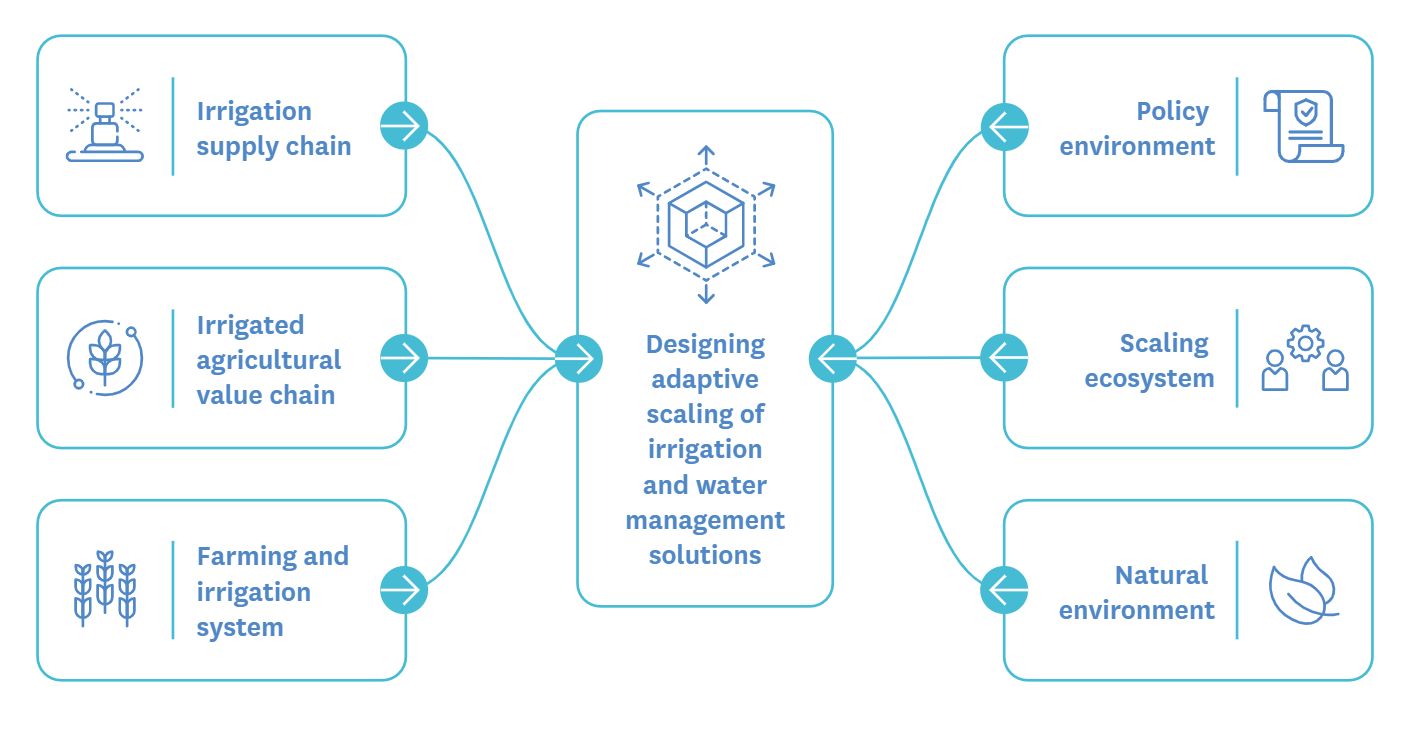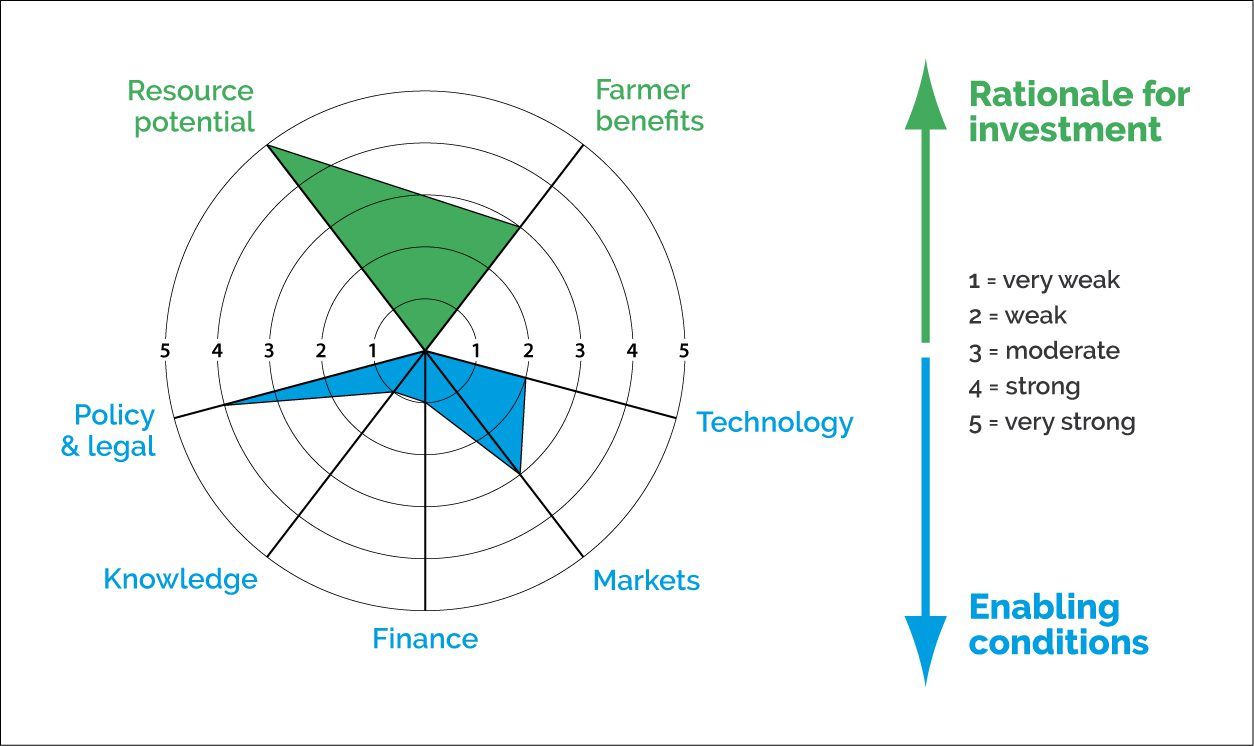By Thai Thi Minh, Senior Researcher – Upscaling Innovations, IWMI
Petra Schmitter, Research Group Leader – Sustainable and Resilient Food Production Systems, IWMI
Making innovative water management and irrigation technologies available to farmers on a massive scale is crucial if we are to meet growing food demands and mitigate climate change impacts. However, scaling efforts often fall short because they do not sufficiently consider the factors enabling and inhibiting farmers’ adoption of these technologies. A new IWMI tool aims to help, by providing a structured guide to analyzing these factors and introducing measures to ensure success.

Although scaling approaches are usually empirical, they do not sufficiently take into account the complex realities of ‘softer elements’ such as people, supply chains, markets, policies and power relations. Consequently, scaling initiatives may not have the desired impact. In some instances, they may even produce undesirable impacts including environmental degradation, loss of access to resources and social inequality.
In recent years, rising agricultural production and the associated pressures on water and other natural resources have underlined the need for additional financing to support the transition to a more sustainable food system. By some estimates, at least USD 300 billion is required annually to meet the Sustainable Development Goals related to food security.
Although agricultural water is still mainly funded by the public sector, private sector organizations and farmers themselves are increasingly making their own investments in water management and irrigation technologies.
This farmer-led irrigation development (FLID) – in which farmers take the lead in establishing, managing and improving irrigated agriculture – is widespread, but growth is constrained and inclusion is limited. There is significant potential for interventions to catalyze FLID processes, and thereby transform food and water security and promote sustainable livelihoods. Solar irrigation, in particular, could be a possible gamechanger in FLID, if it is deployed in a faster and smarter way.
At the same time, simply increasing the quantity of finance flowing to the agricultural water sector is not enough to guarantee the uptake of water solutions. Investments must also be responsible, targeted and bundled with improved inputs and services, market information and access, and digital payment methods.
Following the recent launch of the African Union’s Framework for Irrigation Development and Agricultural Water Management, which reflects the growing interest in improving and harmonizing national and regional water management policies, supporting governments in identifying where and how to invest will also be vital.
Understanding the enabling environment
Drawing on scaling research findings and multi-stakeholder dialogues organized under the Feed the Future Innovation Lab for Small-Scale Irrigation (ILSSI), IWMI’s new tool conceptualizes agricultural innovation scaling processes as an integral part of a systemic and adaptive approach to innovation.
In addition, the tool views agricultural innovation scaling as an iterative process for identifying best-fit solutions and responsibilities for actions. The dissemination/adoption stage and the design and development of (bundled) technologies and practices are intertwined in this process. The systemic analysis can be carried out from different entry points and across levels, as shown in Figure 1.

Source: Minh et al. Forthcoming.
Aimed at implementers – including practitioners, government representatives, private sector actors and donors – the tool guides users through a series of structured steps that lead to a clear understanding of the enabling environment for water solutions. In an (irrigated) agricultural value chain, the enabling environment is composed of the sets of policies, informal institutions, support services and other conditions that create or improve and maintain a general operational environment.
Based on a list of suggested questions, the analysis is expected to result in a country-specific report containing the information necessary to make recommendations for policy, successful scaling programs and alternative scenarios to scale water solutions.
Growing momentum for farmer-led irrigation
The tool was developed in tandem with the upcoming World Bank publication The Farmer-led Irrigation Development Guide – A What, Why and How-to for Intervention Design. The guide serves as a resource pack to help governments, practitioners and other key stakeholders to design public interventions aimed at catalyzing FLID processes.
A simplified analytical framework aids the diagnostic and intervention prioritization approach (Figure 2). The status of a country or region is summarized in a multi-axial spider plot. The justification for FLID is shown in the top half of the plot, and five factors that describe the strength of the enabling environment are shown in the bottom half. Where there are weaknesses in the system, interventions can reduce constraints and catalyze positive change. Example interventions are outlined in the guide.

Source: World Bank. Forthcoming.
IWMI’s tool provides complementary and more detailed methods on how to approach the review of policy, regulatory, and program and project experience, including stakeholder consultations in the diagnostic process. These methods can strengthen the analysis of system factors by facilitating a deeper understanding of system dynamics. Armed with this understanding, efforts to scale water management innovations have a much higher chance of success.

